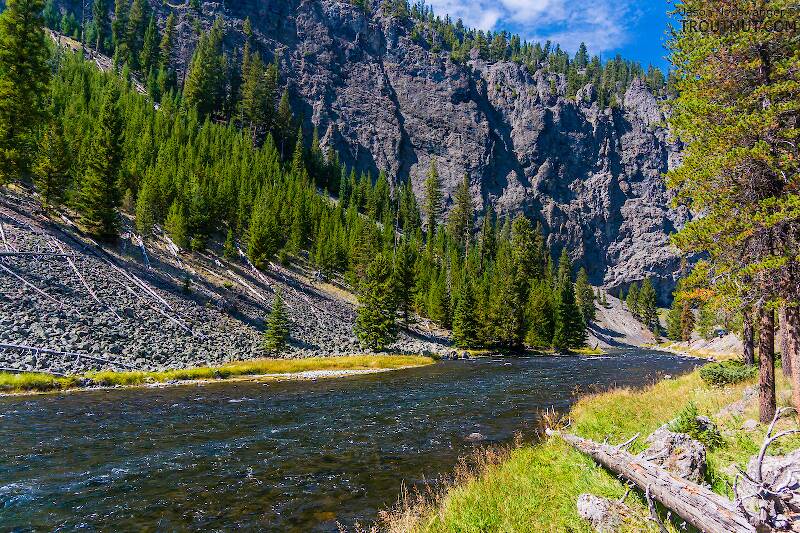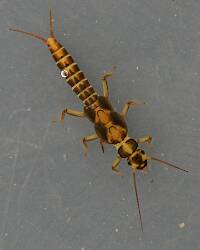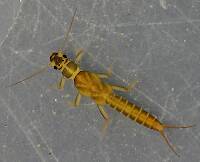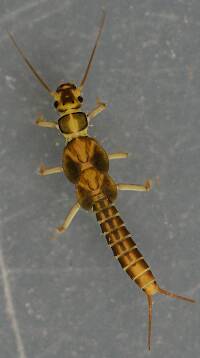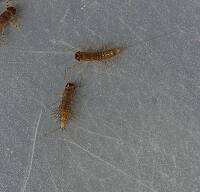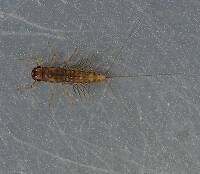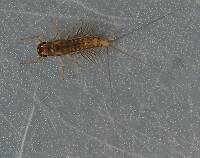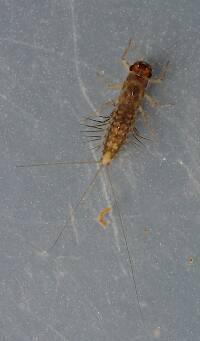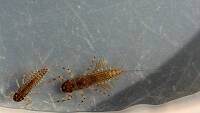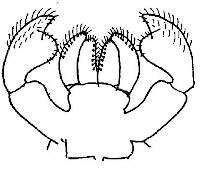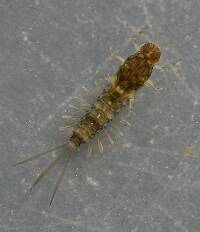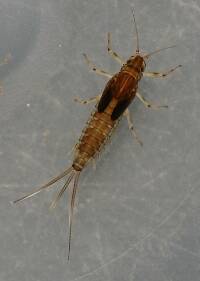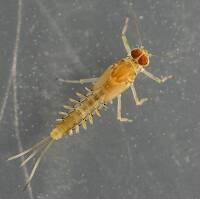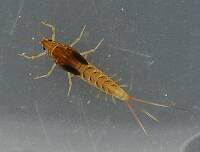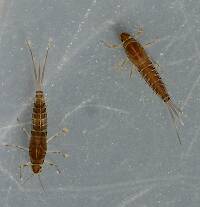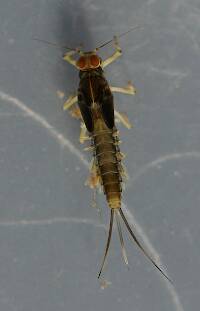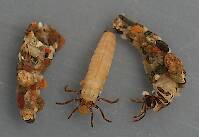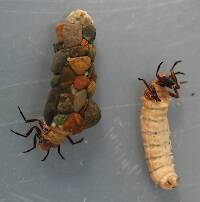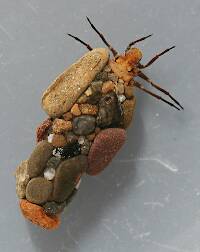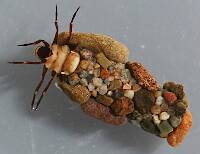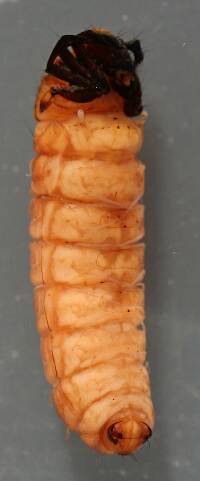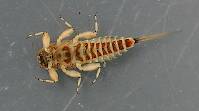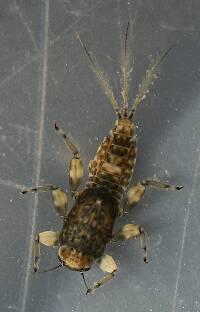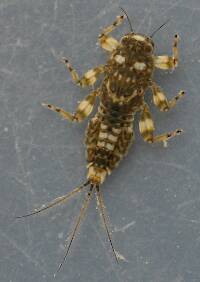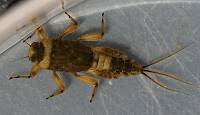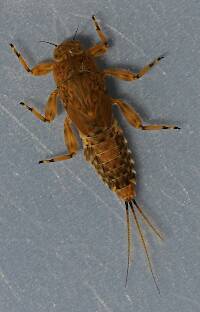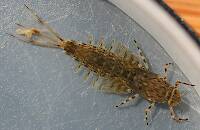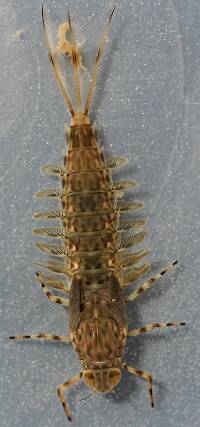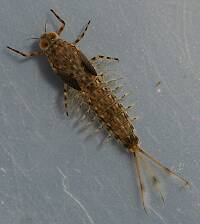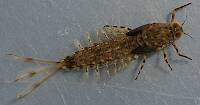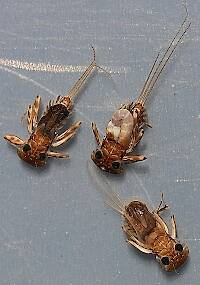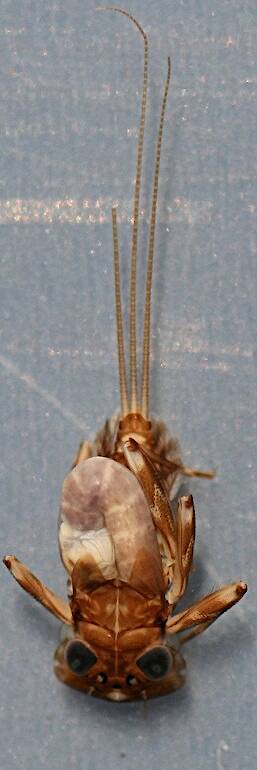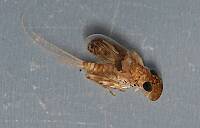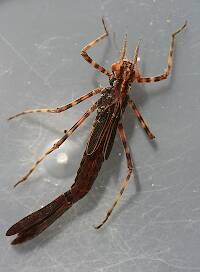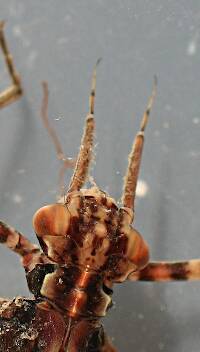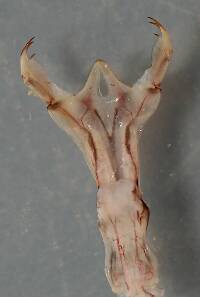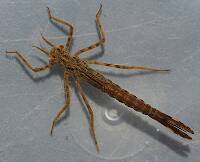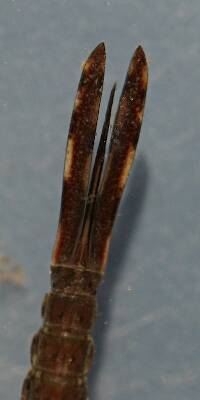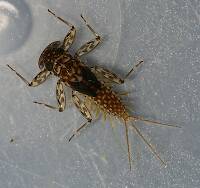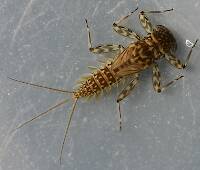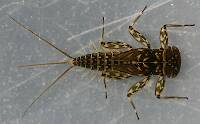
Salmonflies
Pteronarcys californica
The giant Salmonflies of the Western mountains are legendary for their proclivity to elicit consistent dry-fly action and ferocious strikes.
Featured on the forum

This one was surprisingly straightforward to identify. The lack of a sclerite at the base of the lateral hump narrows the field quite a bit, and the other options followed fairly obvious characteristics to Clostoeca, which only has one species, Clostoeca disjuncta.

Troutnut is a project started in 2003 by salmonid ecologist Jason "Troutnut" Neuswanger to help anglers and
fly tyers unabashedly embrace the entomological side of the sport. Learn more about Troutnut or
support the project for an enhanced experience here.
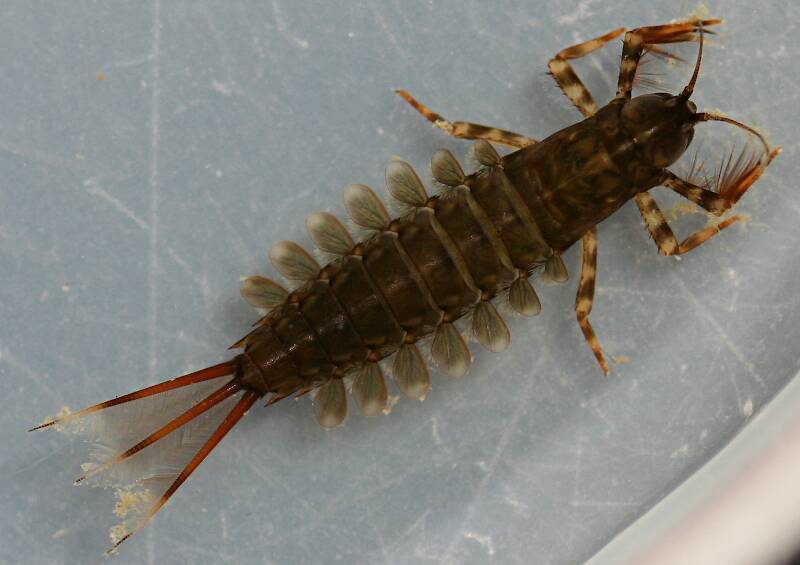
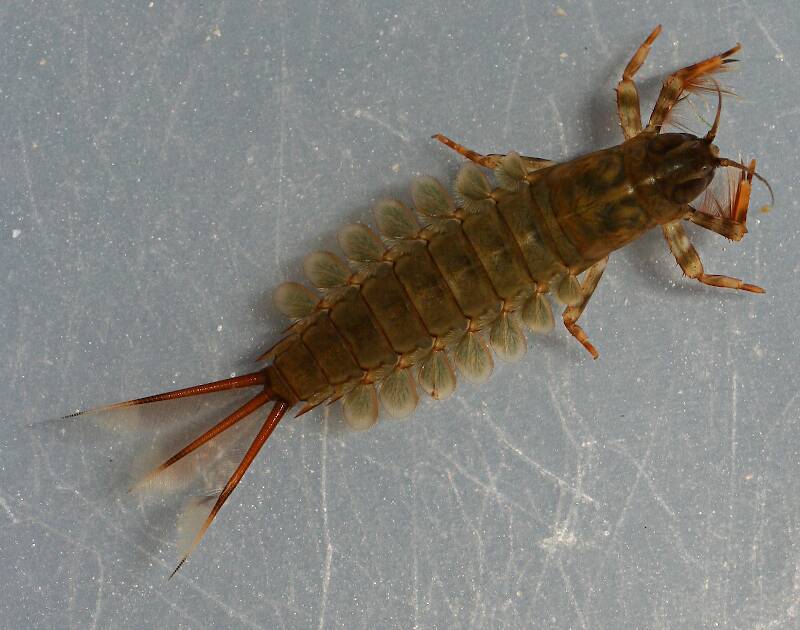
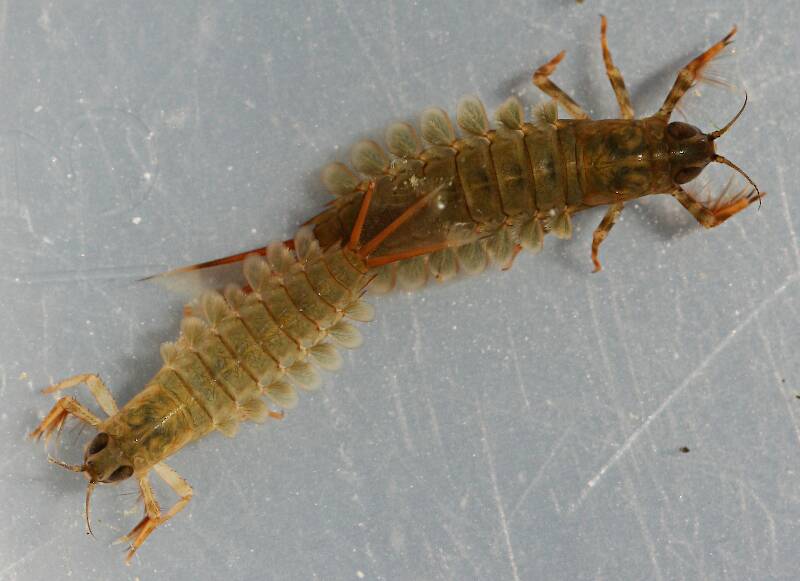
Millcreek on Jul 28, 2014July 28th, 2014, 4:07 pm EDT
Was down at the Russian River yesterday and the Isonychia nymphs are turning up in fairly large numbers. They're probablyIsonychia velma but since I haven't found adults yet there's always the possibility (slim) that they could be a new species. The only keys for nymphs I'm aware of are by Kondratieff and Voshell (1984) and they state that there are very few ways to differentiate among nymphs. Day (1952) reared Isonychia velma nymphs but his description of the nymphs doesn't give any real definitive characters that would separate it from other Isonychia nymphs.
Traditionally Isonychia velma nymphs have been identified through association with adults or by geographical association (thought to be the only species found in California or Oregon).
At any rate, here are a few pictures of the nymphs from the area. The largest nymph (in the first photo) was collected earlier in the month and was added to show how the nymphs get darker as they age.
Traditionally Isonychia velma nymphs have been identified through association with adults or by geographical association (thought to be the only species found in California or Oregon).
At any rate, here are a few pictures of the nymphs from the area. The largest nymph (in the first photo) was collected earlier in the month and was added to show how the nymphs get darker as they age.
"If we knew what it was we were doing, it would not be called research, would it?"
-Albert Einstein
-Albert Einstein
Crepuscular on Jul 31, 2014July 31st, 2014, 7:06 am EDT
Well done once agin thanks for posting. I wish I had more to say about your western bugs!
Millcreek on Jul 31, 2014July 31st, 2014, 10:05 am EDT
Eric - I run into the same problem when it comes to eastern bugs, I can admire them and it's interesting to know more about them but without seeing them in their surroundings or in the flesh there's a bit of a disconnect.
"If we knew what it was we were doing, it would not be called research, would it?"
-Albert Einstein
-Albert Einstein
Entoman on Aug 17, 2014August 17th, 2014, 7:14 am EDT
Very interesting, Mark. Knew they were further down state but didn't know the Russian had them. They are important on the Pit and some waters in Southern Oregon. Their season is coming up pretty quick. They exist in pretty decent numbers in a few places and offer excellent fishing until the big Octobers get going. I carry fancy imitative nymphs but have found a big Black AP works just as well or better. They can be deadly drifted deep and fished with twitches, especially at the margins. They are fast! Sampling them with a drift net is about as effective as trying to catch minnows with it... ;)
BTW, perhaps the difference could be due to recent molting but my samples from fishable hatches show almost black coloration with subtle hints of maroon or purple (especially the gills). Never seen them this light or olive out here. They're usually bigger, too. Perhaps a new species? At least a different form, I suspect. Smaller slightly lighter Velma's are in the Truckee, so perhaps....
BTW, perhaps the difference could be due to recent molting but my samples from fishable hatches show almost black coloration with subtle hints of maroon or purple (especially the gills). Never seen them this light or olive out here. They're usually bigger, too. Perhaps a new species? At least a different form, I suspect. Smaller slightly lighter Velma's are in the Truckee, so perhaps....
"It's not that I find fishing so important, it's just that I find all other endeavors of Man equally unimportant... And not nearly as much fun!" Robert Traver, Anatomy of a Fisherman
Millcreek on Aug 17, 2014August 17th, 2014, 11:18 am EDT
Day collected Isonychia nymphs from the Russian in 1949 near Geyserville. Not too far from where I am. I don't know where he got the nymphs he used for his description since he collected Isonychia from a number of other locations in California including the Trinity and Klamath rivers as well as Putah Creek.
I don't think the color variation is due to recent molts. The specimens I've collected show variation in the small area I've been sampling. Some of it appears due to age. Small instars (5-7 mm) are often almost cream in color.Later instars exhibit the color in the photos or are primarily a medium shade of brown. A few are very dark brown with a head that is nearly black. None show the gill coloring you describe. I haven't found any that are over 16 mm.
There may very well be more than one species in California. I don't know of any work that has been done in California or Oregon on this genus recently. It would be interesting to see and compare samples from different areas.
And yeah, the little guys are fast, flop around a lot too. I've had them jump out of the sieve back into the river while collecting them.
I don't think the color variation is due to recent molts. The specimens I've collected show variation in the small area I've been sampling. Some of it appears due to age. Small instars (5-7 mm) are often almost cream in color.Later instars exhibit the color in the photos or are primarily a medium shade of brown. A few are very dark brown with a head that is nearly black. None show the gill coloring you describe. I haven't found any that are over 16 mm.
There may very well be more than one species in California. I don't know of any work that has been done in California or Oregon on this genus recently. It would be interesting to see and compare samples from different areas.
And yeah, the little guys are fast, flop around a lot too. I've had them jump out of the sieve back into the river while collecting them.
"If we knew what it was we were doing, it would not be called research, would it?"
-Albert Einstein
-Albert Einstein
Oldredbarn on Aug 17, 2014August 17th, 2014, 1:44 pm EDT
Got to love Iso's!
Mark...I'm loving your pics...Just wish you were living here in Michigan...:)
Nice stuff, though!
Welcome aboard, by-the-way! I've been out of touch for a few weeks. I've been on the road out west.
Spence
Mark...I'm loving your pics...Just wish you were living here in Michigan...:)
Nice stuff, though!
Welcome aboard, by-the-way! I've been out of touch for a few weeks. I've been on the road out west.
Spence
"Even when my best efforts fail it's a satisfying challenge, and that, after all, is the essence of fly fishing." -Chauncy Lively
"Envy not the man who lives beside the river, but the man the river flows through." Joseph T Heywood
"Envy not the man who lives beside the river, but the man the river flows through." Joseph T Heywood
Millcreek on Aug 18, 2014August 18th, 2014, 6:27 am EDT
Spence -
Glad you're enjoying the photos. As to living in Michigan, maybe a visit sometime but I like warm weather nine months out of the year, think I'll stick with California.
Let us know about your trip out west. Always enjoy your posts.
Mark...I'm loving your pics...Just wish you were living here in Michigan...:)
Glad you're enjoying the photos. As to living in Michigan, maybe a visit sometime but I like warm weather nine months out of the year, think I'll stick with California.
Let us know about your trip out west. Always enjoy your posts.
"If we knew what it was we were doing, it would not be called research, would it?"
-Albert Einstein
-Albert Einstein
Oldredbarn on Aug 19, 2014August 19th, 2014, 2:47 pm EDT
Mark,
I wrote a nice fishing report about my couple days on the Bighorn, the darn thing timed out and I forgot to cut and paste to save it...Not sure I have the energy to reproduce it. :)
Spence
I wrote a nice fishing report about my couple days on the Bighorn, the darn thing timed out and I forgot to cut and paste to save it...Not sure I have the energy to reproduce it. :)
Spence
"Even when my best efforts fail it's a satisfying challenge, and that, after all, is the essence of fly fishing." -Chauncy Lively
"Envy not the man who lives beside the river, but the man the river flows through." Joseph T Heywood
"Envy not the man who lives beside the river, but the man the river flows through." Joseph T Heywood
Quick Reply
Related Discussions
Topic
Replies
Last Reply
5
Jan 11, 2015
by Entoman
by Entoman
4
Sep 27, 2014
by Millcreek
by Millcreek

